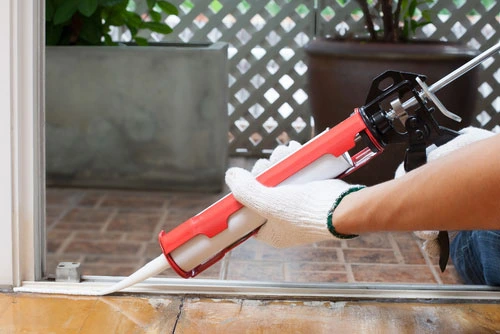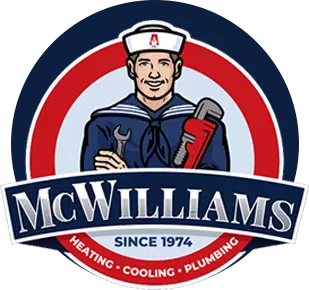Blog
Introduction
Sealing Air Leaks in Your Nacogdoches Home Weeds Out Inefficiencies. A leaky home is an inefficient home. Fortunately, even if your home was not built as tightly as you may wish, you have the power to seal air leaks and weed out inefficiencies. The two main tools available for sealing air leaks are weatherstripping and caulk. Here’s what you need to know about each air-sealing tool.
What Is Weatherstripping?
 Open a window or door and look for a strip of material the window or door closes on when you shut it. This is weatherstripping, used to decrease air leaks around operable windows and door jambs. The material usually comes on a spool and has one adhesive side you apply to the window or door jamb.
Open a window or door and look for a strip of material the window or door closes on when you shut it. This is weatherstripping, used to decrease air leaks around operable windows and door jambs. The material usually comes on a spool and has one adhesive side you apply to the window or door jamb.
Various types of weatherstripping are available in assorted depths and widths. Levels of effectiveness and durability also vary for different situations. The type you choose depends on the surface you’re sealing and the aesthetic you want from the finished product.
What Is Caulk?
Look carefully around the outside of window and door frames. You might spot a white substance with a slightly squishy texture. This is caulk, a flexible material used to seal stationary joints around windows, doors and other wall or ceiling penetrations up to 1/4-inch wide. Caulk comes in a disposable cartridge, which fits into a caulking gun for application. Caulk may also come in an aerosol can, squeeze tube or rope for special applications.
The same as weatherstripping, various types of caulk are available for indoor and outdoor applications with varying levels of water resistance, strength and other properties. Some are water-based while others are solvent-based, and the price points vary as well.
Tips For Applying Weatherstripping
With the correct weatherstripping selected, you’re ready to apply the product. Always consult the instructions on the weatherstripping package. In addition, keep these basic tips in mind for sealing air leaks with weatherstripping:
- Clean and dry the surface you plan to weatherstrip.
- Only apply weatherstripping when the temperature exceeds 20 degrees outside.
- Measure the areas you plan to add weatherstripping to. Add 5 to 10 percent to this number, since it’s better to trim off a little excess at the end than to cut too short of a piece.
- Transfer this measurement to the weatherstripping. As a carpenter would advise, measure twice and cut once to ensure the proper length.
- Apply the weatherstripping snugly against the entire surface, including the corners, for a complete seal when the window or door is closed.
- Test the application by checking that the material compresses when you shut the window or door.
Tips For Applying Caulk
You don’t need any special training to apply caulk, but the process can turn messy without the proper guidance. Follow the instructions on the caulk cartridge. Also, keep the following tips for sealing air leaks with caulk in mind:
- Clean all areas you plan to caulk. This includes scraping away old caulk and peeling paint with a screw driver, putty knife, stiff brush or solvent.
- Only apply caulk if it’s above 45 degrees outside.
- Dry the area completely so you don’t seal any moisture into the surface you’re caulking.
- Hold the caulk gun at a constant 45-degree angle. This sends caulk deep into the cracks around the window or door frame and helps prevent bubbles from forming.
- Apply the caulk in a straight, continuous stream and avoid stopping and starting for a smooth application.
- Release the trigger before pulling the gun away to avoid applying too much. Guns with an automatic release make this easier.
- If caulk oozes from the crack, push it back in with a putty knife.
- Check that the caulk is sticking to both sides of the crack. Don’t skimp; apply two layers if necessary.
Why Is Sealing Air Leaks Important?
By caulking and weatherstripping the cracks around windows and doors, you can expect the following benefits:
- Lower heating and cooling bills thanks to less air infiltration.
- Improved structural durability because moisture problems are less prominent in well-sealed homes.
- Increased comfort in the form of fewer drafts and cold spots.
- Healthier indoor environment because outdoor allergens can’t make their way in through gaps and cracks around windows and doors.
It’s important to keep in mind that a well-sealed home may require a controlled ventilation system to maintain proper air exchange between the interior and the outdoors for good indoor air quality.
For more tips about sealing air leaks in your Nacogdoches home, please contact McWilliams Heating, Cooling and Plumbing today. Our experience dates back to 1974.
Image Provided by Shutterstock.com
Share This :
Emily
Table of Contents
Discover New Blog Posts
Detecting under-slab leaks is crucial for homeowners looking to protect their property and avoid costly repairs. These leaks occur when water begins to seep through […]
In Cleveland, maintaining an effective HVAC system is essential for home comfort, especially during peak seasonal changes. Your air conditioning unit relies on its circuit […]
HVAC systems play a crucial role in maintaining the comfort and safety of homes, especially in Pecan Grove. One of the key components of these […]






 7
7 
